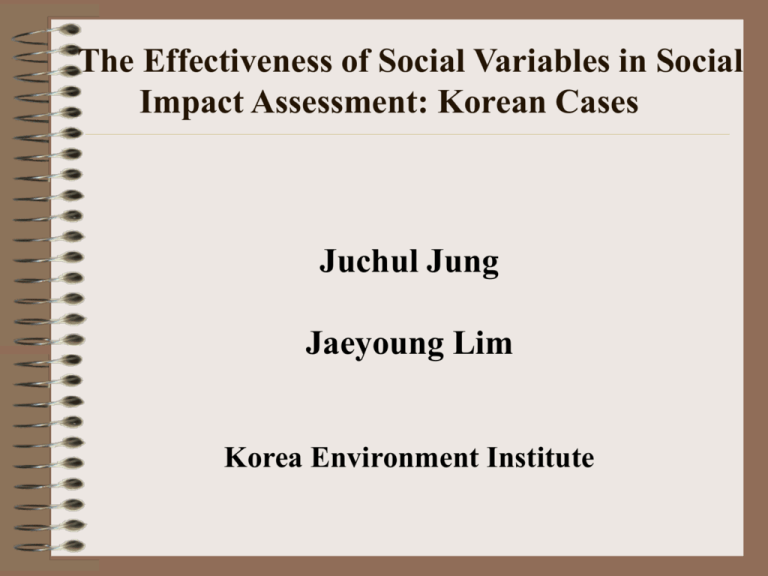Korean Cases
advertisement

The Effectiveness of Social Variables in Social Impact Assessment: Korean Cases Juchul Jung Jaeyoung Lim Korea Environment Institute I. Objective Finding Social Variables that are relevant to Korean Cases Developing the Effectiveness of Social Impact Assessment through Selecting Effective Social Variables Understanding Specificity of Certain Social Variables in Local Contexts II. Methodology Performing Literature Review about Social Variables in SIA Selecting and Reviewing Six Different Typical EIA Cases in Korea (EIA reports) Employing ‘Scoping’ to Sort Out Which Social Variables Prove Effective in Korean Cases III.1 Social Variables by IOCGP and Burge III.2 Social Variables by Vanclay • 1) Health and Social Well-being Impacts • 2) Living Environment Impacts • 3) Economic Impacts and Material Well-being Impacts • 4) Cultural Impacts • 5) Family and Community Impacts • 6) Institutional, Legal, Political and Equity Impacts • 7) Gender Relations Impacts III.3.1 Comparisons between IOCGP and Vanclay’s Social Variables IOCGP Vanclay Population Characteristics Health and Social Well-being Impacts Community and Institutional Changes Living Environmental Impacts Political and Social Resources Economic Impacts and Material Well-being Impacts Individual and Family Changes Cultural Impacts Community Resources Family and Community Impacts Institutional, Legal, Political and Equity Impacts Gender Relations Impacts III.3.2 Vanclay’s Social Variables Differentiating Social Impacts from Social Changes Accusing IOCGP of not separating Social Changes from Social Impacts Changes are neutral; Impacts are not. Variables are suggestions; not meant to be checklists V. Social Variables in Korean EIA Recently (2006), only population, residence, and industry are currently reviewed in EIA. Population - Impacts of Dense Population on Environment - The Extent of Dense Population and Mitigation Policies Residence - Impacts on Residence and Mitigation Policies Industry - Impacts on Industrial Structure - Impacts on Fishery and Agriculture Public Infrastructure - Impacts on Capacity of Public Infrastructure Education - Impacts on Capacity of Education Facilities Traffic Cultural Heritage - Changes in Traffic Congestion and Road Conditions - Impacts on Parking Space and Bus Stops - Impacts on Landscape - Impacts on Cultural Heritage IV. Korean Cases (2000~) Case 1: Kyungin Canal Porject Case 2: Saemangeum Reclamation Project Case 3: Seoul Outer-Ring Road (Sapaesan Tunnel) Case 4: Kyoungbu High Speed Rail (Chungsungsan Tunnel) Case 5: Radioactive Waste Disposal (Buan) Case 6: Hantan River Dam V-1 Why these cases? • Environmental conflict cases (selected by Korean central government) • EIA was prepared, but failed to lessen or mitigate social conflict • To check which social variable is effective in those cases for social impact assessment V-2 Social Variables (To be included in SIA) VI. Implication • Stakeholder analysis missed • In particular, NGO proved very important, but excluded. ex) Engineer, Economist, Environmental scientist, Sociologist, Affected People, and NGO VII. Conclusion and Implication • Current Korean SIA in EIA insufficient and ineffective in content and process • Stakeholder analysis and public participation (NGO) needed • The integration of Vanclay’s method into Burdge’s in selecting social variables



